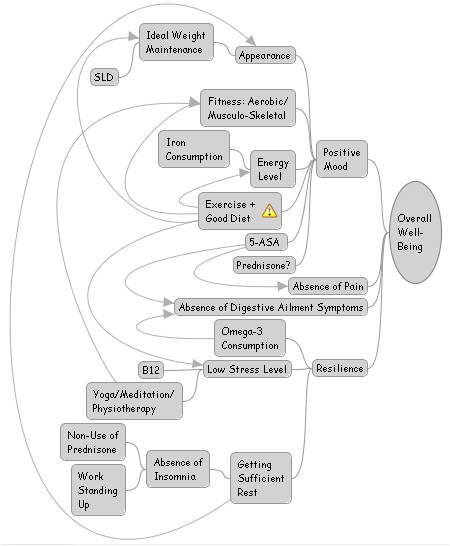This article is the concatenation and update of three previous articles on Personal Knowledge Management (PKM). It will be published later this year as a chapter in a compendium book on emerging trends in KM.
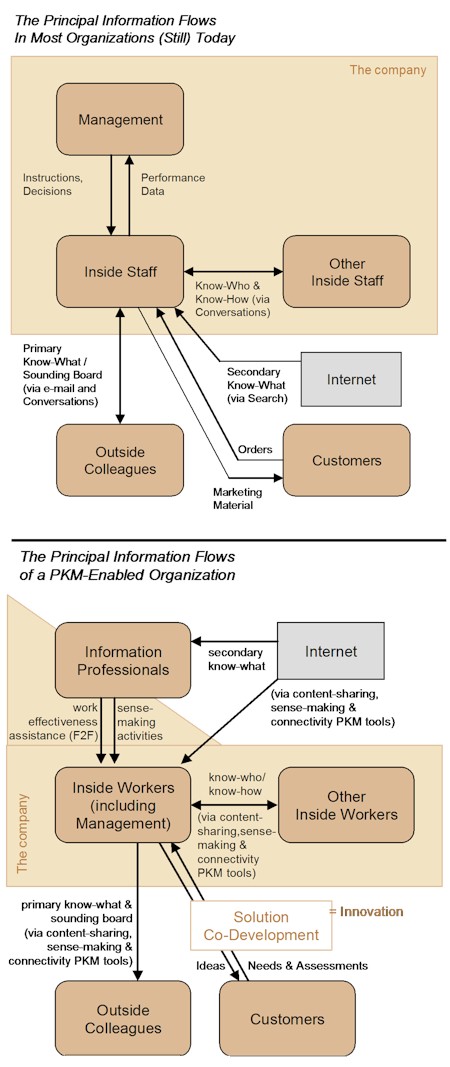
In North America at least, Knowledge Management (KM) budgets are under constant siege, KM leaders’ salaries and department headcounts have been cut back, the Knowledge Director role has been relegated to a subordinate back-office role, and many CEOs are searching for ways to outsource the function entirely. In other words, most executives either do not see KM as strategic to their organizations, or have lost faith that investment in KM offers an appropriate ROI.
It’s time for the knowledge ‘champions’ of the world to get together, and to get our act together. As much as the idea of increasing the sharing and effective use of information and ideas is appealing to just about everyone, KM has not delivered on this promise. I believe time is running out.
The story of KM so far has been, for the most part, a failure — failure to articulate, to imagine, and to implement. We allowed the bold vision of knowledge-sharing to be diminished and appropriated by those who saw it is merely an exercise in automating the acquisition, storage and dissemination of documents. Many IT departments saw it as another facet of technology — as competition for resources and as little more than an extension of the document management and website management functions they were already responsible for. Many training departments saw it as the ‘content’ side of training, and wondered why it didn’t report to them. Most executives saw it as a means to speed up and reduce the cost of the back office, the same way the assembly line had reduced manufacturing times and costs. And the creative people who often had the Knowledge Director thrust upon them conceived of KM as a means for increasing organizational innovation, customer satisfaction and employee retention.
Now, a dozen years after the debut of KM, there has been little significant change in the efficiency, effectiveness or value of information processes or content in most organizations. Many companies that jumped early onto the KM bandwagon have all but abandoned it, while many organizations that waited are now repeating the mistakes of the pioneers. Despite this, interest in KM remains substantial, and this is because, while its promise has not really been realized, its potential is still enormous. And CEOs of many organizations, having studied the lessons of Enron, 9/11, Katrina and the Flu, have a nagging feeling that, no matter how great the cost of investing in KM may be, the ‘cost of not knowing’ is even greater:
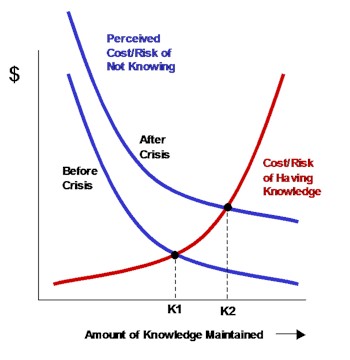
What most organizations essentially did with KM was automate existing information processes. They took the paper ‘stuff’ in manuals and memoranda and newspapers and converted it into digital form. That made it easier and (sometimes) cheaper to maintain, but did not increase its value, which was, if you were to ask most of the people on the front line, pretty marginal anyway. Organizations provided staff with access to the Internet, but most of those who were inclined to use it already had it at home and were using it there, without the restrictions imposed by the company — so that, too, was of marginal benefit. In some cases employees are still forced to shuttle critical information between their work and home PCs.
Most organizations, too, refused to abandon the top-down centralized information model that was already in place, merely institutionalizing it with firewalls, access restrictions, monster centrally-managed one-size-fits-all databases and websites and over-engineered, over-managed collaboration and community-of-practice tools.
Essentially, neither managers nor early KM practitioners ‘got it’: KM is all about enabling people to obtain relevant, context-rich information, and connection with appropriate experts, easily, when they need it, so that they can be more effective doing their unique jobs.
As a result, the critical business information flows, shown in the top diagram above, are essentially unchanged from what they were a decade ago. There have been some minor changes in the technologies used for these flows, but for the most part these have not been significant in improving front-line effectiveness of workers, and in some cases have actually made work more difficult. Management continues to rely on well-entrenched IS to promulgate instructions and policy decisions and to extract, often annoyingly and disruptively, information from the front lines that it needs to make business decisions. To traditional managers, information is still all about telling employees what to do and making sure they do it.
Customers, outside the corporate firewalls and disinclined to participate in technology initiatives designed for the suppliers’ needs rather than theirs (as most e-newsletters, e-rooms and Extranets are), continue to interact, information-wise, with suppliers the same way they always have — receive (and usually turf) the marketing mail, put in their orders and rely on their ‘relationship manager’ to decipher the former and process the latter effectively. Business as usual, largely unaffected by KM.
Things happen the way they do in organizations for a reason. When people are unable to get the information they need ‘within the system’, they will find workarounds to get it in other ways. This is nothing new, and it is commendable — it shows people care about the quality and effectiveness of their work. The #1 means of getting and sharing information is, was, and probably always will be conversations. Pick up the phone, walk down the hall, use IM (if your company allows it), use Skype (if your company allows it), or, as a last resort, send an e-mail to the people who might know what you need to know.
It would make sense that KM would facilitate conversations, but if anything it has tried to obsolesce them — substituting context-poor databases that purportedly have the information you used to get from talking with people, more efficiently. Not surprisingly, this has rarely worked.
What we in KM need to do is go back to the original premise and promise of KM and start again — but this time from the bottom up:
- Develop processes and programs, and buy or build tools, that measurably improve the effectiveness of front-line workers in the performance of their unique and increasingly-specialized jobs;
- Refocus from top-down centralized content acquisition and collection to peer-to-peer content-sharing;
- Develop processes and programs, and buy or build tools, that measurably improve sense-making: the value and meaning of content in context;
- Refocus from top-down community-of-practice management to enabling peer-to-peer expertise-finding and connectivity.
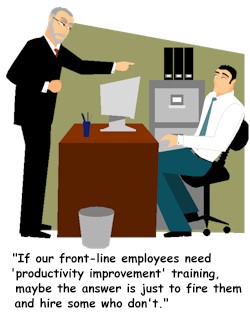 This bottom-up approach to KM, directed at the needs of individual employees and their peer-to-peer interactions has come to be called Personal Knowledge Management (PKM). It offers tremendous possibilities, and could finally realize the original promise and expectations of KM, but it can’t be done within the budget that most organizations set aside for KM. It requires a recognition from management that the four sets of activities bulleted above will, if properly implemented, yield huge improvements in the quality and effectiveness of the organization’s people’s work — repaying the investment many times over. The quote at right is what one executive told me when I suggested his company make such an investment. It shows that, in many companies, labour costs are still seen as a necessary evil to be minimized, and an additional investment in people, or knowledge for them, is out of the question. This bottom-up approach to KM, directed at the needs of individual employees and their peer-to-peer interactions has come to be called Personal Knowledge Management (PKM). It offers tremendous possibilities, and could finally realize the original promise and expectations of KM, but it can’t be done within the budget that most organizations set aside for KM. It requires a recognition from management that the four sets of activities bulleted above will, if properly implemented, yield huge improvements in the quality and effectiveness of the organization’s people’s work — repaying the investment many times over. The quote at right is what one executive told me when I suggested his company make such an investment. It shows that, in many companies, labour costs are still seen as a necessary evil to be minimized, and an additional investment in people, or knowledge for them, is out of the question.
Fortunately, management of most organizations has more sense than that. The breakeven point for an investment of two hours of personal coaching for each employee in an organization is, after all, a mere 0.1% improvement in that employee’s work effectiveness. And, while some executives may be impatient and disenchanted with the return on their KM investment to date, they still appreciate Drucker’s argument that improving front-line worker productivity is “the greatest challenge of the 21st century” — that the answer isn’t to do as much with less investment, but to do much more with more.
The lower diagram at the top of this article shows what’s possible — how valuable information flows could be enabled and facilitated by PKM. Step by step, here is what we would need to do to realize this potential:
Revamp and upgrade the role of Information Professionals from content managers to personal work effectiveness enablers. Most knowledge workers have figured out how to get the content they need to do their jobs well, without any help from KM. Centralized content management initiatives offer little or no incremental value to them. What they need is hands-on help using the information and technology at their disposal more effectively in the context of doing their own unique jobs. This does not lend itself, in most organizations, to either classroom or computer-based training — it needs to be face-to-face, anthropological: The IP needs to observe how the worker uses technology and information now, and then advise them how to do so more effectively. And at the same time, the IP needs to help each worker organize their personal content so that they can manage it effectively and find (again) what they need when they need it. We need to get IPs away from their collections and help-desks and out into the field helping workers one-on-one. This is the essence of PKM.
Reintermediate Information Professionals to filter and add sense, meaning and value to information content. One of the initial goals of KM was disintermediation — getting rid of the layers between front-line people and useful information. The problem is, most front-line people are now overwhelmed with the volume of information coming at them, and find most of what is available on the Internet too raw for their needs: They need help making meaning and sense of this information. IPs, as reintermediaries, can fill this need in two ways: They can massage raw information using visualizations, maps, tableaux, systems thinking charts, single frames, decision trees and other techniques, and they can add insight by synthesizing, analyzing, organizing and providing context for this information so that, in the hands of the knowledge worker, it is easily understandable, compelling and ready to apply.
Develop simple, automated mechanisms to facilitate peer-to-peer content-sharing with others inside and outside the organization. These mechanisms include:
- Customizable, easy-to-use, context-rich personal workspaces (similar to weblogs, but with additional functionality, security, and flexibility, while still being easy to learn and use) where all personal information that is shareable with others can reside.
- Automatic peer-to-peer publishing and subscription mechanisms that allow employees’ shareable content to be accessed by others, and high-value content from the Internet, and from other employees and outside colleagues, to flow automatically to the employee’s desktop.
- Automatic knowledge harvesting mechanisms that pull employees’ shareable content into a central searchable archive copy, to obviate the need for ‘submitting’ knowledge to central repositories.
Develop mechanisms to enhance meaning and context of information content so that it ‘makes more sense’ and has more value to users. These mechanisms include:
- Templates, e-mail lists, lists of ‘experts’ and other aids for identifying and asking the right people for the right information on a quick-turnaround basis, in a single, easy-to-use just-in-time canvassing application.
- Templates and models for creating high-context stories and narratives.
- Templates, models and self-study modules for creating visualizations, maps, single frames and other compelling, meaningful representations of information.
- Templates, models and self-study modules for creating systems thinking charts, structured thinking documents, analytical reports and other insightful distillations and interpretations of information.
- Templates, models and self-study modules for creating mindmaps, open space events and other support mechanisms that enhance the effectiveness of, and document, conversations.
- Templates, models and self-study modules for improving observation, listening and attention skills (e.g. cultural anthropology tools).
- Tools and mechanisms for surveying employees, customers and the ‘informed’ public and otherwise tapping the ‘Wisdom of Crowds’ (including ‘prediction markets’ and decision support applications).
Develop mechanisms to enable peer-to-peer expertise finding and connectivity. These mechanisms include:
- Simple, one-click virtual presence applications for connecting person-to-person with people (individually and in groups), with full audio (including ability to record), video, whiteboard (see what others in a conference are looking at and doing) and application sharing capabilities.
- Simple, intuitive collaborative workspaces and worktools (enhanced, simplified versions of wikis, BaseCamp etc.)
- Well-designed, automated people-finding applications and directories.
- Simple presence-detecting and peer-to-peer introduction applications (enhanced, simplified versions of Dodgeball etc.)
The following table contrasts the traditional, top-down, just-in-case content-and-collection KM approach with the bottom-up, peer-to-peer, just-in-time, reintermediated, context-connection-and-sensemaking PKM approach:
| KM Program Objective: |
Traditional KM Approach: |
PKM Approach: |
| Knowledge ‘User Training’ |
Enterprise application training
(classroom, CBT and newsletters distributed top-down) |
Personal Productivity Improvement (PPI);
Personal Content Management (PCM) |
| Content Sharing* |
Top-down collection in central repositories;
Formal submission process |
Personal Shared Workspaces;
P2P Publishing & Subscription;
Automatic Content Harvesting
|
| Sense-Making & Context Enhancement |
(not addressed) |
Just-in-Time Canvassing;
Stories & Narratives;
Visualizations;
Insight Analyses;
Conversation Support;
Observation Support;
Surveying, Predicting & Decision-Making |
| Connectivity* |
Community of Practice management;
Network mapping |
Virtual Presence;
Collaborative Workspaces/Tools;
People-Finders;
P2P Presence Detecting and Introduction |
| Role of Information Professionals |
Repository Management
Website Management |
Personal Work Effectiveness (PPI + PCM);
Sense-Making & Context Enhancement |
*Content sharing and connectivity tools are collectively known as ‘social networking’ applications.
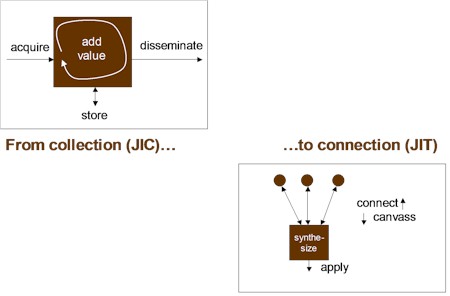
Executives preoccupied with risk and cost minimization will continue to wait on the sidelines for pioneers to show them that the risks and costs of such programs are far outweighed by the benefits of better productivity, more engaged, informed and insightful employees, better connectivity, more context-rich knowledge-sharing and improved collaboration among employees and outside experts.
I first got interested in the idea of bottom-up personal knowledge management, focused on the unique needs of each front-line employee, in 2003, my last year as Global Director of Knowledge Innovation for a major professional services firm. I’d been asked to investigate a leveling-off of use of the firm’s award-winning centralized knowledge resources, and decided to do the research through personal interviews with non-users, rather than the usual user surveys. We did about 100 interviews, and tried to get at the root causes of the problems and concerns they cited. So for example while many interviewees said they ‘couldn’t find’ what they were looking for, we tried to discover why this was: Was the tool too complex? Was the training inadequate? Was there too much content to wade through? Did they just not know where to look? Was the content badly indexed? Was it in the wrong format for convenient (re-)use? Or perhaps what they sought didn’t exist at all. Or worse, they weren’t motivated to make the effort to look for it.
In describing this work I’ve used three of the interviews that were especially illuminating. One of these was a corporate finance practitioner who confessed he’d completely stopped reading newspapers because ‘general’ knowledge was unnecessary for his work, and used his PC only for e-mail and business valuation spreadsheets. A second was an audit manager who said she couldn’t ‘afford’ the intrafirm charge for research work and simply had no time to do such research herself, so she did without; she also confessed that she’d never been taught how to find stuff on her own PC and could never find what she needed on her own hard drive. A third was a tax partner who delegated all ‘knowledge work’ to subordinates or assistants, even printing out and routing his e-mails. When I asked him about Instant Messaging, he said he ‘handled it the same way’. Ouch!
My conclusion from the interviews was that most of the firm’s front-line people didn’t use the knowledge resources because they didn’t know how. I had been reading about a KM process that entailed one-on-one coaching of front-line people to use knowledge and technology effectively, and named this (for internal selling purposes, and with a tip of the hat to Drucker) Personal Productivity Improvement (PPI). When I proposed PPI as the solution to ineffective knowledge use, however, my boss said he was doubtful that, if they weren’t willing to take the time to attend the firm’s courses or computer-based training on the use of knowledge resources, employees were just as unlikely to make time for PPI. He sent me back to find out why practitioners didn’t know how to use the resources effectively.
When I went to conduct the second round of interviews, it became clear that some of the interviewees had given me the answers they thought I wanted to hear because they didn’t know the real answers. They were also blunter and more forthcoming when I went back to suggest that perhaps their ignorance of use of the firm’s knowledge resources was partly their fault. This time, the corporate finance practitioner told me he was paid for his specialized technical knowledge, not for his understanding of business issues. He described the powerful, integrated newsfeeds and personalizable news profiles, the paintakingly populated databases, and the collaborative spaces we provided as “nice to have, not need to have”. He was, he said, “unmotivated, so far” to learn more about what we had made available.
The audit manager pulled out an independent consultant’s report that listed in the criteria clients used to select a professional services firm. In order they were (1) strong pre-existing relationship with someone on the team, (2) fit and likability of the pursuit team, (3) senior face time spent with client key decision makers during the pursuit process, (4) technical competency and experience of the pursuit team, (5) understanding of the client’s processes and organization, and (6) understanding of the client’s business and industry. There is just no time, she told me, for stuff that clients don’t think very important. If she had more time, she said, she would be spending it out at clients building relationships, not at her PC looking for knowledge. [I later interviewed some clients who somewhat sheepishly corroborated the findings in this report, and said this audit manager was wise in setting her priorities.]
And the tax partner grabbed me as I passed near his office, whisked me inside, and told me how delighted he was that, after I’d mentioned it, he’d got his assistant to show him how to use Instant Messaging. “If a client calls me on the phone with a question, sometimes I can IM a staff member and get confirmation of the answer while the client is still online, so I save research time and the client is very impressed”, he told me. “It’s stuff like this IM that really makes you guys valuable, not those giant repositories you build.” If that weren’t distressing enough, he confided that he was concerned that some of those ‘giant repositories’ were accessible to everyone in the firm, and could we please restrict access to these to tax practitioners only? He patted me on the back. I sighed.
So my conclusion this time around was that the centralized content we spent so much time and money maintaining was simply not very useful to most practitioners. The practitioners I talked to about PPI said they would love to receive PPI coaching, provided it was focused on the content on their own desktops and hard drives, and not the stuff in the central repositories.
Subsequently I met with a number of the firm’s competitors, and KM leaders of several other organizations that have experienced some frustration with the performance of their KM programs, and almost all of them expressed substantial interest in (and sympathy for) these findings and this approach.
From these interviews and subsequent discussions with leading KM gurus, notably the UK’s David Gurteen, emerged the concept of Personal Knowledge Management (PKM). Some of the PKM elements are starting to be used, at least in part and in pilots, in quite a few organizations.
Here’s a primer on how some of these elements can be introduced in your organization:
Personal Productivity Improvement: (leading practice: Ernst & Young, KPMG)
- Pre-interview each employee in the organization to understand their job, what knowledge and technology they use and how they use it.
- Pre-assemble a file of possible ‘leave-behinds’ — ‘cheat sheets’, step-by-step instructions, FAQs, bookmark lists etc. that the employee is likely to find useful, based on your previous PPI sessions with others with similar jobs or learning styles.
- If you don’t already have a personal content management program (see below) get this set up for the employee first.
- Schedule about an hour face-to-face with the employee. The first half-hour should be spent observing and asking questions of the employee to identify significant productivity problems. The second half-hour should be spent showing the employee more effective ways of doing their work, stepping them through the leave-behinds, answering questions and getting feedback from the employee on the value they feel they have received from the session.
- Compile a list of observations and systemic problems that PPI cannot resolve, and present them to senior management for them to address.
Personal Content Management:
- Work with each individual employee to help them organize and index their ‘My Documents’ and e-mail folders in a way that makes sense for them. A standard firm-wide taxonomy is rarely appropriate and with current technology it is no longer necessary. Each person’s files should be set up the way they would set up their personal filing cabinet if the documents were all hard-copy. Rather than by subject-matter, the most effective organization scheme is often ‘taskonomic’ rather than taxonomic — indexed by how or when it will be (re-)used.
- Deploy Google Desktop or some other fast, simple, powerful desktop search tool.
- Use RSS feeds to simplify ‘publishing’ and ‘subscribing’ to others’ content, and show employees how to use them and how to integrate this content into their personal taxonomy.
- If you have canvassing and/or harvesting programs (see below) show employees how to use them and how to integrate this content into their personal taxonomy.
- Develop and disseminate (with simple one-page instructions or FAQs) routines and practices for effectively capturing, filing and finding relevant knowledge in the context of what it is to be used for.
Personal Shared Workspaces, Publishing & Subscription:
- Educate the project team.
- Identify the pilot group: There are three constituencies in organizations who will more readily see the benefits of using personal shared workspaces and who are therefore natural pilot groups: (a) subject matter experts who are inundated with requests for information and advice, who could benefit from having their ‘electronic filing cabinet’ accessible to and browsable by others in the organization, (b) those in the company who are already publishing newsletters and similar regular bulletins, and (c) those who are coordinating community of practice networks.
- Develop a starting personal ‘taskonomy’ and starting personal content archive for each pilot group member.
- Select and adapt a commercial weblogging tool and/or develop your own personal shared workspace tool.
- Get the IT subteam to: Convert personal content archives to HTML & ëbulk publishí them, create a personal TOC for each group member, and develop a password protection scheme.
- Offer everyone in the firm a brief seminar on personal shared workspace publishing & subscribing. Let interest in using these tools spread virally.
- Talk up personal shared workspaces outside the organization.
- Set up a personal shared workspace help/monitoring group.
Automatic Content Harvesting: (leading practice: Hill & Knowlton)
- Create separate Public and Private ‘My Documents’ and e-mail folders on each employee’s hard drive.
- Whenever users ‘save’ or store a document or message, prompt them to decide whether the document should be stored in the Public (shareable) or Private folder.
- Establish an automated mechanism like RSS to regularly ‘harvest’ the Public folder information, to a central mirror site that other users can browse, and/or in response to just-in-time canvassing searches (see below), peer-to-peer.
- Encourage people in the organization who maintain the most valuable context-rich content (e.g. subject matter experts, network coordinators and newsletter editors) to use personal shared workspaces (see above) to post and archive their content as part of their Public folder.
Just-in-Time Canvassing, and People-Finders: (leading practice: Lend Lease corporation)
- Use social network analysis (mapping or interviewing) to identify the de facto networks of expertise and trust in the organization.
- Use these to identify network coordinators, the ‘people to go to first’ on key subject matter areas for your organization.
- Have these coordinators create, maintain and publish Canvassing Lists (e-mail groups) with e-mail, IM, phone and other contact information for the people in these subject matter networks, so that anyone in the firm who wants to canvass people in a network can do so with one click. These lists should include experts outside as well as inside the organization.
- Create Canvassing Templates, forms that people can fill in quickly and simply to describe what expertise they’re looking for, and then send them to one or more Canvassing Lists.
- Devise a simple one-page instruction sheet/FAQ on how to effectively use the Canvassing Lists and Templates, which communication media to use in different circumstances to contact them, and how to deal with telephone tag, non-responses and other situations when canvassing response is inadequate. It should also deal with appropriate etiquette and protocols to ensure the canvassing process isn’t abused.
- If you also have an Auto-Harvesting program (see above), consider putting experts’ weblogs and other context-rich resources in the Canvassing List to use as a surrogate for people who are unable or unwilling to respond to canvassing requests personally.
For many organizations, the traditional approach to KM is no longer a viable option. I believe PKM offers a sensible alternative, one that draws on some of the success stories in social networking and some pioneering programs of some of the world’s leading knowledge-enabled organizations. It also resonates with the ways in which we have always shared what we know most effectively: through conversations, stories, just-in-time inquiries through those we know and trust, learning by watching others, and copying others on documents, messages and learnings we believe they would find valuable.
This is a complex system approach to KM: It respects that things happen in organizations the way they do for a reason, and that people will find workarounds whenever processes, including knowledge processes, work suboptimally. Rather than trying to impose new processes and infrastructure on people, PKM attempts to support and reflect the ways we intuitively learn and share what we do. It adapts technology to people’s behaviour, rather than forcing behaviour to adapt to new technology.
What is missing, still, is more pioneers. Cost reduction, outsourcing and risk management are the strategic issues of the day in the corner offices of most organizations, and improving employees’ work effectiveness and the quality of their work are not as high on the priority list. The onus is on us as KM champions to create new, compelling value propositions for KM (and specifically PKM), to produce business models that measure what’s important and come up with astonishing ROIs for investment in PKM activities, to stress the Cost of Not Knowing without scare-mongering, and to continue to do small-scale experiments and share the results of our experiments with each other. That’s the only way to get the attention of senior executives, and get them to startinvesting again.
And this time, once we do get that attention and investment, we’d better learn from past mistakes and do the job right. |



 One of the things that astonished me about last summer’s new immigrant marches in American streets was the ferocious xenophobia that they stirred among Americans. Survey after survey showed that, far from rousing public sentiment to the plight of illegal aliens and the struggles of new Americans to settle in the Land of Opportunity, these shows of Latin-American solidarity roused fear and revulsion among a wide swath of Americans who generally agree on little: racists, the unemployed and under-employed, crime-obsessed conservatives, white xenophobic homeowners who equate immigration with lower property values, libertarians who equate immigration with more demands on public health and education systems they would like to see dismantled, and even environmentalists who equate immigration with more suburban sprawl, pollution, population pressure on wilderness lands, and resource depletion.
One of the things that astonished me about last summer’s new immigrant marches in American streets was the ferocious xenophobia that they stirred among Americans. Survey after survey showed that, far from rousing public sentiment to the plight of illegal aliens and the struggles of new Americans to settle in the Land of Opportunity, these shows of Latin-American solidarity roused fear and revulsion among a wide swath of Americans who generally agree on little: racists, the unemployed and under-employed, crime-obsessed conservatives, white xenophobic homeowners who equate immigration with lower property values, libertarians who equate immigration with more demands on public health and education systems they would like to see dismantled, and even environmentalists who equate immigration with more suburban sprawl, pollution, population pressure on wilderness lands, and resource depletion.


 A while ago I wrote an article entitled
A while ago I wrote an article entitled 

 This bottom-up approach to KM, directed at the needs of individual employees and their peer-to-peer interactions has come to be called Personal Knowledge Management (PKM). It offers tremendous possibilities, and could finally realize the original promise and expectations of KM, but it can’t be done within the budget that most organizations set aside for KM. It requires a recognition from management that the four sets of activities bulleted above
This bottom-up approach to KM, directed at the needs of individual employees and their peer-to-peer interactions has come to be called Personal Knowledge Management (PKM). It offers tremendous possibilities, and could finally realize the original promise and expectations of KM, but it can’t be done within the budget that most organizations set aside for KM. It requires a recognition from management that the four sets of activities bulleted above 

 The birth of the de-centered self can be profoundly disorienting, it is transcendental and often involves a heightened sense of awareness and connection. The analytical ‘localized’ self can find it fragile, frightening and impossible to grasp…There is a sense of being present to what is seeking to emerge,
The birth of the de-centered self can be profoundly disorienting, it is transcendental and often involves a heightened sense of awareness and connection. The analytical ‘localized’ self can find it fragile, frightening and impossible to grasp…There is a sense of being present to what is seeking to emerge, 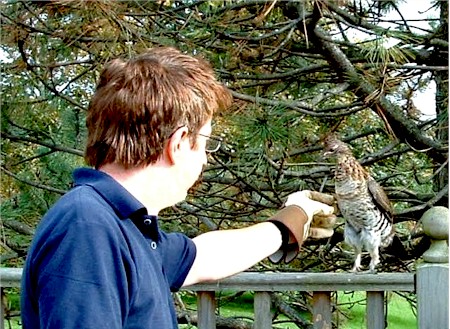 ‘PucPuc’ is as close as I can get to the gentle, almost inaudible purr/coo/cluck sound that our friendly neighbourhood ruffed
‘PucPuc’ is as close as I can get to the gentle, almost inaudible purr/coo/cluck sound that our friendly neighbourhood ruffed 